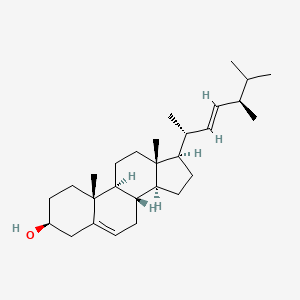| Authors | Title | Published | Journal | PubMed Link |
|---|---|---|---|---|
| Herath HM et al. | New secondary metabolites from bioactive extracts of the fungus Armillaria tabescens. | 2013 | Nat. Prod. Res. | pmid:23140424 |
| Ito N et al. | An ultra performance liquid chromatographic method for determining phytosterol uptake by Caco-2 cells. | 2012 | Anal. Biochem. | pmid:22119071 |
| Evidente A et al. | Soyasapogenol B and trans-22-dehydrocam- pesterol from common vetch (Vicia sativa L.) root exudates stimulate broomrape seed germination. | 2011 | Pest Manag. Sci. | pmid:21480462 |
| Pereira M et al. | Cloning, mechanistic and functional analysis of a fungal sterol C24-methyltransferase implicated in brassicasterol biosynthesis. | 2010 | Biochim. Biophys. Acta | pmid:20624480 |
| Schrøder M et al. | Effect of rapeseed oil-derived plant sterol and stanol esters on atherosclerosis parameters in cholesterol-challenged heterozygous Watanabe heritable hyperlipidaemic rabbits. | 2009 | Br. J. Nutr. | pmid:19772679 |
| Herchi W et al. | Phytosterols accumulation in the seeds of Linum usitatissimum L. | 2009 | Plant Physiol. Biochem. | pmid:19616960 |
| Chen Q et al. | Dietary phytosterols and phytostanols alter the expression of sterol-regulatory genes in SHRSP and WKY inbred rats. | 2009 | Ann. Nutr. Metab. | pmid:19851062 |
| Rozner S et al. | Inhibition of cholesterol transport into skin cells in cultures by phytosterol-loaded microemulsion. | 2008 | Chem. Phys. Lipids | pmid:18395012 |
| Silva L et al. | Nystatin-induced lipid vesicles permeabilization is strongly dependent on sterol structure. | 2006 | Biochim. Biophys. Acta | pmid:16626629 |
| Zhao HB et al. | Ganoderma total sterol (GS) and GS1 protect rat cerebral cortical neurons from hypoxia/reoxygenation injury. | 2005 | Life Sci. | pmid:15607331 |
Brassicasterol
Brassicasterol is a lipid of Sterol Lipids (ST) class. Brassicasterol is associated with abnormalities such as Systemic disease and Diabetes Mellitus. The involved functions are known as Drug Interactions, cholesterol metabolism, Synthesis, cholesterol absorption and Increased Cholesterol Synthesis. Brassicasterol often locates in Back, Cell membrane and Tissue membrane. The related lipids are Total cholesterol, Sterols, campesterol, brassicasterol and lathosterol.
Cross Reference
Introduction
To understand associated biological information of Brassicasterol, we collected biological information of abnormalities, associated pathways, cellular/molecular locations, biological functions, related genes/proteins, lipids and common seen animal/experimental models with organized paragraphs from literatures.
What diseases are associated with Brassicasterol?
Brassicasterol is suspected in Systemic disease, Diabetes Mellitus and other diseases in descending order of the highest number of associated sentences.
Related references are mostly published in these journals:
| Disease | Cross reference | Weighted score | Related literature |
|---|
No disease MeSH terms mapped to the current reference collection.
PubChem Associated disorders and diseases
What pathways are associated with Brassicasterol
There are no associated biomedical information in the current reference collection.
PubChem Biomolecular Interactions and Pathways
Link to PubChem Biomolecular Interactions and PathwaysWhat cellular locations are associated with Brassicasterol?
Visualization in cellular structure
Associated locations are in red color. Not associated locations are in black.
Related references are published most in these journals:
| Location | Cross reference | Weighted score | Related literatures |
|---|
What functions are associated with Brassicasterol?
Related references are published most in these journals:
| Function | Cross reference | Weighted score | Related literatures |
|---|
What lipids are associated with Brassicasterol?
Related references are published most in these journals:
| Lipid concept | Cross reference | Weighted score | Related literatures |
|---|
What genes are associated with Brassicasterol?
There are no associated biomedical information in the current reference collection.
What common seen animal models are associated with Brassicasterol?
There are no associated biomedical information in the current reference collection.
